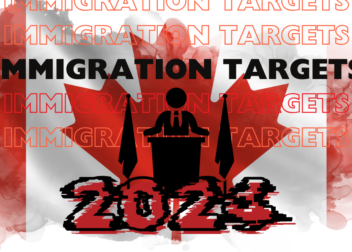Canada Immigration 2024: Introduction to the Demographic Shift in Canada
Canada is experiencing a significant demographic transition characterized by an aging population and evolving immigration trends. As the baby boomer generation retires, the elderly proportion of the population increases. This shift impacts various socio-economic aspects, with the median age rising and projections indicating that by 2030, nearly a quarter of the population will be 65 or older.
Immigration Canada 2024 policies are crucial for balancing economic growth and demographic sustainability. Historically, immigration has driven population growth and economic vitality, but recent trends show fewer new immigrants, which could worsen the challenges of an aging population. The interaction between a growing elderly demographic and fewer immigrants creates complex economic dynamics.
Understanding the current immigration landscape is vital. Canada’s immigration policies focus on attracting skilled workers, entrepreneurs, and family reunification. Immigrants significantly contribute to the labor market, innovation, and economic prosperity. However, with fewer immigrants entering the country, questions arise about economic growth sustainability and supporting an aging population.

– Panetta Family
This blog post dissects the economic impacts of these demographic changes, exploring how fewer immigrants may influence healthcare, labor markets, and social services. Examining the intersection of an aging population and reduced immigration helps understand the potential challenges and opportunities for Canada in 2024 and beyond.
Canada has long relied on immigration as a cornerstone of its economic strategy. Historically, immigrants have shaped the labor market, driven innovation, and fostered economic development. They address labor shortages and enhance the diversity and dynamism of the Canadian workforce. Immigrants bring a variety of skills, experiences, and cultural perspectives, enriching Canada’s social and economic fabric.
Immigration remains significant for economic growth. Immigrants fill essential roles across sectors like healthcare, technology, construction, and agriculture, helping mitigate the impacts of an aging population and declining birth rates. They are often entrepreneurial, establishing businesses that create jobs and stimulate economic activity, contributing to GDP growth.
Immigrants also drive innovation, bringing specialized expertise and fresh perspectives that advance technology and research. This is evident in industries like information technology, engineering, and life sciences, where immigrant professionals pioneer new developments, bolstering Canada’s reputation for innovation.
Regional growth also benefits from immigration. Smaller communities and rural areas, struggling with population decline and economic stagnation, are rejuvenated by new residents. Immigrants contribute to local economies and community vitality.
As Canada faces demographic challenges, the need for a steady influx of immigrants becomes critical. Their contributions maintain economic stability and ensure Canada thrives in a competitive global economy.
As Canada’s population ages, reduced immigration could significantly impact the labor market. A steady influx of immigrants has been vital for filling labor shortages. Declining immigration could exacerbate workforce gaps, particularly in healthcare, technology, and skilled trades.
Without sufficient immigration, Canada in 2024 may struggle to maintain a robust labor market. As the workforce ages, more retirements and fewer young workers entering the workforce could decrease skilled labor availability, challenging businesses to find qualified candidates.
Labor shortages could affect productivity and economic output. Businesses struggling to fill positions may face decreased efficiency and slower growth. Essential services like healthcare could strain, affecting residents’ quality of life. The tech industry, critical for innovation, may suffer from a lack of skilled professionals, hindering technological development.
Reduced immigration can also increase wage pressures as employers compete for fewer workers. While benefiting employees short-term, this could raise operational costs for businesses, leading to higher consumer prices and potentially stifling economic growth.
In conclusion, fewer immigrants in Canada could significantly challenge labor market stability. Addressing these issues requires strategic planning and policy adjustments to ensure a capable workforce supporting economic ambitions and maintaining a high standard of living.

Public Services and Social Security
As Canada faces a demographic shift with an aging population, the role of immigration becomes increasingly crucial in sustaining public services and social security systems. With fewer immigrants arriving, the country’s healthcare, pensions, and other social services could experience significant strain. An aging population typically demands more healthcare services, which can be challenging to meet with a shrinking workforce. The reduced number of working-age individuals paying taxes could lead to a shortfall in funding for essential services, exacerbating the pressure on the healthcare system.
The pension system is another area of concern. With a growing number of retirees and fewer workers contributing to pension plans, the financial sustainability of these plans is at risk. The Canada Pension Plan (CPP), for example, relies on the contributions of current workers to pay out benefits to retirees. Without sufficient immigration to bolster the workforce, the CPP could face funding challenges, potentially leading to reduced benefits or increased contribution rates for future generations.
Beyond healthcare and pensions, other social services such as education, housing, and social assistance programs may also be affected. Fewer immigrants could result in reduced economic growth, which in turn impacts government revenues and the ability to fund these programs. This could lead to cuts in services or increased taxes, placing a greater burden on the remaining working population.
Moreover, the broader economic implications of fewer immigrants extend to the labor market and productivity. Immigrants often fill essential roles in various sectors, contributing to overall economic dynamism. A decline in immigration could result in labor shortages, hampering economic growth and innovation. This, coupled with the increasing demands of an aging population, underscores the importance of immigration in maintaining the balance and sustainability of Canada’s public services and social security systems.
Innovation and Economic Dynamism
Immigration has long been a cornerstone of Canada’s economic vitality, particularly in fostering innovation and entrepreneurial activities. Immigrants bring diverse perspectives and skills, which are essential to the development of new technologies and the formation of startups. Numerous studies have shown that immigrant entrepreneurs are more likely to start businesses compared to their native-born counterparts, thereby creating jobs and contributing to economic growth.
In the context of immigration Canada 2024, the role of immigrants in driving technological advancements cannot be overstated. Immigrants often fill critical roles in STEM (Science, Technology, Engineering, and Mathematics) fields, where there is a shortage of skilled labor. Their contributions to research and development spur innovations that enhance productivity across various sectors. For instance, many tech startups in cities like Toronto and Vancouver are led by immigrant founders, whose innovative solutions address both local and global challenges.
A decline in immigration would likely stifle this economic dynamism. With fewer immigrants, the pool of talent available for entrepreneurial ventures and technological innovation would shrink, leading to a potential slowdown in economic growth. This is particularly concerning in an aging society like Canada, where the native-born workforce is gradually decreasing. Immigrants not only replenish the labor market but also bring fresh ideas that rejuvenate industries and drive economic progress.
Moreover, immigrants contribute to the entrepreneurial ecosystem by attracting venture capital and fostering international trade links. Their diverse backgrounds enable them to identify unique market opportunities and navigate different cultural contexts, making them valuable assets to Canada’s economy. A reduction in immigration could therefore lead to a less dynamic and less competitive economic landscape, hampering Canada’s ability to innovate and grow.
In sum, the relationship between immigration and economic dynamism is profound. Immigrants are key drivers of innovation, technological advancements, and entrepreneurial activities that underpin economic growth. A decline in immigration rates poses significant risks to these critical areas, potentially impeding Canada’s economic prosperity.
We were terrified of the cold land and the large amount of snow, where people were different and spoke a foreign language.
Anonietta Lanni nee Venditti
Regional Economic Disparities
As Canada grapples with an aging population and reduced immigration, the economic impacts will not be uniformly distributed across its vast geography. Urban centers and rural areas are likely to experience these challenges in markedly different ways, with significant implications for regional economic stability and growth.
Urban areas, particularly major cities such as Toronto, Vancouver, and Montreal, have traditionally been the primary destinations for immigrants. These cities benefit from a steady influx of new residents who contribute to local economies through labor, entrepreneurship, and consumer spending. A reduction in immigration can lead to labor shortages, particularly in sectors heavily reliant on immigrant workers, such as technology, healthcare, and hospitality. Additionally, the demand for housing may decline, potentially impacting real estate markets and construction industries.
Conversely, rural areas and smaller towns, which already face challenges in attracting and retaining residents, may encounter more severe economic difficulties. These regions often depend on immigration to counteract population decline and support local industries, including agriculture and manufacturing. Reduced immigration can exacerbate workforce shortages, hinder business growth, and lead to a decline in public services as the tax base shrinks. This can create a vicious cycle where economic opportunities diminish, further discouraging new residents and investment.
The disparities between urban and rural regions highlight the need for tailored policy responses to address the unique challenges faced by different parts of the country. Ensuring a balanced approach to immigration policies can help mitigate the adverse economic impacts and support equitable growth across Canada. Addressing these regional disparities is crucial for maintaining the overall economic health and social cohesion of the nation as it navigates the complexities of an aging population and shifting immigration patterns.
Policy Responses and Recommendations
As Canada faces the dual challenge of an aging population and declining immigration rates, it becomes imperative to explore strategic policy responses to mitigate the economic impacts. One of the most crucial strategies is to enhance domestic labor force participation. Encouraging higher participation rates among underrepresented groups such as women, indigenous populations, and older workers can significantly bolster the workforce. Initiatives such as offering affordable childcare, implementing flexible working conditions, and providing retraining programs for older workers can collectively improve participation rates, thereby offsetting some of the economic strain caused by fewer immigrants.
Another vital policy response involves enhancing national productivity levels. Investment in technology and innovation can drive productivity gains, which, in turn, can partially compensate for the reduced influx of new talent. Government policies that incentivize research and development, support small and medium-sized enterprises, and foster an environment conducive to technological advancements are essential. Additionally, improving the skill set of the existing workforce through continuous education and vocational training programs will ensure that Canadian workers are equipped to thrive in an increasingly dynamic and competitive global market.
Adjusting immigration policies to better align with Canada’s economic needs is also a critical recommendation. While the current immigration policies have been beneficial, a more targeted approach may yield better results. Emphasizing skilled immigration that directly addresses labor shortages in key sectors such as healthcare, technology, and engineering can help maintain economic stability. Streamlining the immigration process to make it more efficient and welcoming for skilled workers would also be advantageous. Furthermore, policies that support the integration and retention of immigrants can enhance their contributions to the economy and society at large.
Collectively, these strategies offer a comprehensive approach to addressing the economic challenges posed by an aging population and fewer immigrants. By focusing on increasing domestic labor force participation, enhancing productivity, and refining immigration policies, Canada can better navigate the economic impacts and continue to thrive in the coming years.
Conclusion and Future Outlook
The economic impacts of a declining number of immigrants to Canada, coupled with an aging population, present significant challenges. As detailed in earlier sections, the interplay between immigration and economic vitality is crucial. A reduction in immigration Canada 2024 could result in labor shortages, decreased consumer spending, and potential stagnation in innovation. These factors are pivotal as the country grapples with the needs of an aging demographic.
However, Canada is well-positioned to address these challenges through proactive and adaptive measures. Policymakers must prioritize creating a conducive environment for immigrants, ensuring they have adequate support to integrate and contribute effectively. Enhancing the attractiveness of life in Canada through robust healthcare, education, and social services will be crucial in maintaining a steady inflow of new residents.
Additionally, there is a need to focus on the retention of skilled workers and the development of homegrown talent. Strengthening vocational training and higher education can help bridge potential skill gaps. Encouraging older individuals to remain in the workforce through flexible working arrangements and incentives could also alleviate some of the pressures associated with an aging population.
Innovative policies that address regional disparities can further support economic stability. For instance, directing immigration to areas with labor shortages can help balance economic growth across provinces. Moreover, fostering a culture of entrepreneurship and supporting small businesses can stimulate local economies and generate employment.
In conclusion, while the economic impacts of fewer immigrants and an aging population pose significant challenges, Canada has a range of tools at its disposal to navigate these issues. By adopting comprehensive and forward-thinking strategies, the country can sustain its economic growth and continue to thrive amidst demographic changes.
Stay updated with immigrid!


